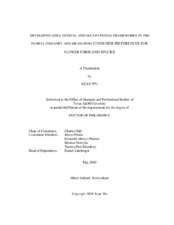| dc.contributor.advisor | Hall, Charlie | |
| dc.creator | Wu, Xuan | |
| dc.date.accessioned | 2021-01-08T20:02:25Z | |
| dc.date.available | 2022-05-01T07:13:38Z | |
| dc.date.created | 2020-05 | |
| dc.date.issued | 2020-03-23 | |
| dc.date.submitted | May 2020 | |
| dc.identifier.uri | https://hdl.handle.net/1969.1/191922 | |
| dc.description.abstract | The floral industry has been facing challenges due to structural changes over the past few decades. Intensifying competition between retail florists and other shopping channels continue to impact the industry, which leads to a significant decline in the employment of floral designers and sales of floral products in retail shops. Across the nation, industry firms and educational institutions have been seeking strategies to cope with these challenges. This research study aims to provide information for the industry and academia to make more informed decisions.
An exhaustive environmental scan was conducted regarding the educational and career pathways and occupational skill qualifications in the floral industry. Based on the information collection and analysis, major educational and career pathway components were identified. Diagrams with the interconnections of all pathway components were created, and education programs of major pathway components were characterized.
The occupational skill qualifications framework included four levels of qualifications of floral designers. The roles and duties of each level were defined. Up to ten competency categories for each level were identified.
A survey study was conducted to evaluate the identified competencies and practicality of the two frameworks by industry professionals and gained insights from them on the suggestions for improvement. The likelihood of using the two frameworks developed showed that a total of 80% and 88% of survey respondents expressed likely or very likely to use these two frameworks, respectively.
Lastly, a consumer research study was conducted that focused on consumers preferences’ and willingness to pay for flower form and species. For flower form study, the results indicated that at both low and high price points, consumers placed the highest value in geometric designs. Both parallel design and line flower significantly increased willingness to pay at high price point. For species substitution study, no statistically significant difference was shown in either willingness to pay or beauty rating between expensive and inexpensive species. For individual flower symmetry study, rose was rated the highest on attractiveness, followed by dahlia and ranunculus. Anthurium was rated the lowest. Radial flowers were considered most appealing, bilaterally symmetrical flowers had the lowest beauty rating. The results of this study could potentially assist designers in future business decisions. | en |
| dc.format.mimetype | application/pdf | |
| dc.language.iso | en | |
| dc.subject | Floral industry | en |
| dc.subject | education | en |
| dc.subject | occupation | en |
| dc.subject | consumer preferences | en |
| dc.title | Developing Educational and Occupational Frameworks in the Floral Industry and Measuring Consumer Preferences for Flower Form and Species | en |
| dc.type | Thesis | en |
| thesis.degree.department | Horticultural Sciences | en |
| thesis.degree.discipline | Horticulture | en |
| thesis.degree.grantor | Texas A&M University | en |
| thesis.degree.name | Doctor of Philosophy | en |
| thesis.degree.level | Doctoral | en |
| dc.contributor.committeeMember | Palma, Marco | |
| dc.contributor.committeeMember | Pierson, Elizabeth (Betsy) | |
| dc.contributor.committeeMember | Murphrey, Theresa Pesl | |
| dc.contributor.committeeMember | Neshyba, Monica | |
| dc.type.material | text | en |
| dc.date.updated | 2021-01-08T20:02:25Z | |
| local.embargo.terms | 2022-05-01 | |
| local.etdauthor.orcid | 0000-0002-8649-0228 | |


